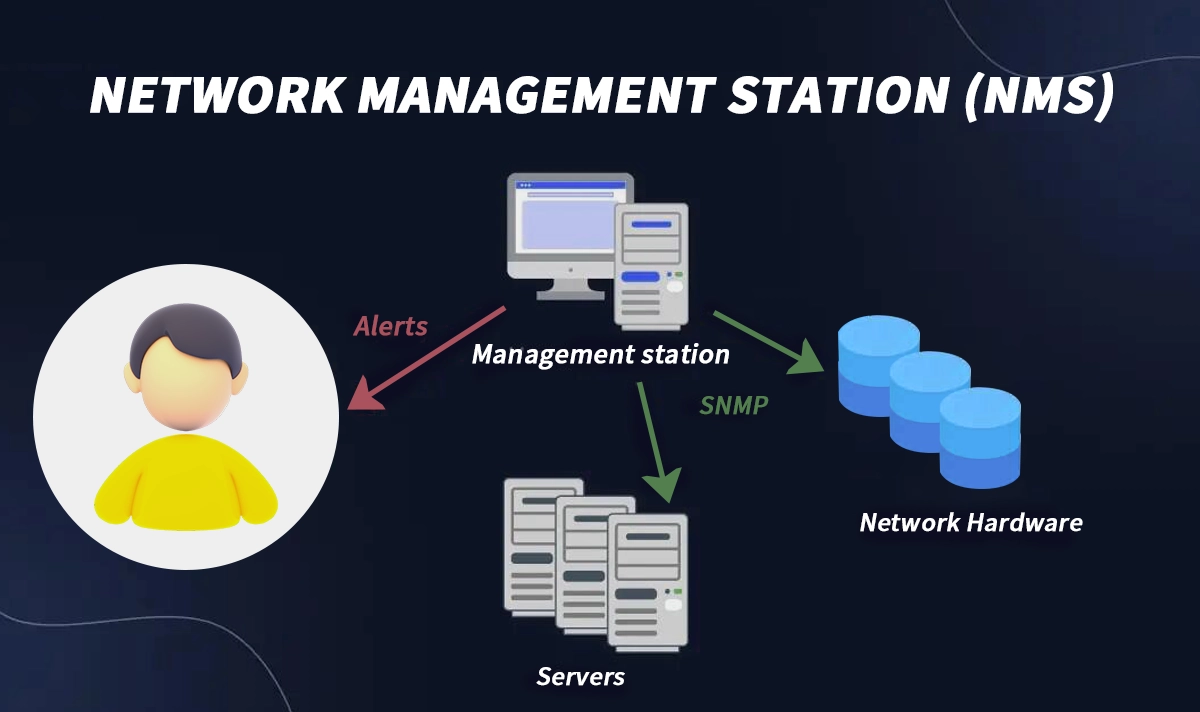
In today's interconnected world, a robust and efficient network is the backbone of any successful organization. As networks grow in complexity, managing them manually becomes a daunting task. This is where a Network Management System (NMS) comes into play. In this comprehensive guide, we'll explore what an NMS is, its key benefits, core components, and how it integrates with modern hardware like optical transceivers. We'll also highlight how solutions from LINK-PP can enhance your network performance. Whether you're an IT professional or a business leader, this article will provide valuable insights to help you streamline your network operations.
📌 Key Takeaways
A Network Management System (NMS) lets you watch and control your whole network from one spot. This makes it easier to find and fix problems fast.
Main parts of an NMS are device discovery, monitoring, configuration management, alerting, and reporting. These parts help your network work better.
An NMS does simple jobs like updates and alerts by itself. This saves you time and lowers the chance of mistakes.
Picking the best NMS means you look at what your network needs. You also compare features and think about how it can grow with your business.
Checking and caring for your network with an NMS keeps it safe and steady. This helps you stop big problems before they start.
📌 What is a Network Management System (NMS)?
A Network Management System (NMS) is a suite of software and hardware tools designed to monitor, administer, and maintain computer networks. It enables IT teams to oversee network performance, detect issues proactively, and ensure optimal uptime. Key functions include:
Fault Management: Identifying and resolving network anomalies.
Performance Monitoring: Tracking metrics like bandwidth usage and latency.
Configuration Management: Automating device setups and changes.
Security Management: Enforcing policies to protect against threats.
Accounting Management: Monitoring resource allocation and usage.
An effective NMS is crucial for enterprises relying on seamless connectivity, and it forms the foundation for scalable network infrastructure. By leveraging an NMS, organizations can reduce downtime, improve efficiency, and support business growth.

📌 Why is an NMS Important? Key Benefits Unveiled
Implementing a Network Management System offers numerous advantages that translate into tangible business outcomes. Here are some of the top benefits:
Proactive Issue Resolution: Detect problems before they impact users, minimizing downtime.
Cost Savings: Automate routine tasks, reducing the need for manual intervention.
Enhanced Security: Monitor for suspicious activities and enforce compliance.
Scalability: Easily manage expanding networks without compromising performance.
Data-Driven Insights: Generate reports for informed decision-making.
For instance, using an NMS for enterprise network management can lead to a 30% reduction in operational costs, according to industry studies. With solutions like those from LINK-PP, businesses can achieve these benefits while integrating seamlessly with existing hardware.
📌 Core Components of a Modern NMS
A typical NMS comprises several interconnected components that work together to provide comprehensive network oversight. These include:
Network Monitoring Tools: Track real-time performance and health.
Automation Engines: Handle repetitive configurations and updates.
Alerting Systems: Notify administrators of critical events.
Reporting Dashboards: Visualize data for easy analysis.
Integration APIs: Connect with third-party systems and devices.
Each component plays a vital role in ensuring that your network remains resilient and adaptive. For example, LINK-PP's NMS solutions include advanced dashboards that simplify network performance optimization, making it easier to manage complex environments.
📌 The Role of Optical Modules in Network Management
Optical transceivers, such as transceivers, are critical hardware components that facilitate high-speed data transmission over fiber optic networks. They convert electrical signals into light and vice versa, enabling long-distance and high-bandwidth communication. In an NMS, monitoring these modules is essential for maintaining network integrity.
Why Optical Modules Matter in NMS:
They provide insights into physical layer performance, including signal strength and error rates.
Malfunctioning modules can cause network slowdowns or failures, which an NMS can detect early.
Integrating module data into the NMS allows for predictive maintenance and inventory management.
LINK-PP Optical Modules for Seamless Integration:
LINK-PP offers reliable optical modules designed to complement modern NMS setups. For instance, the LINK-PP SFP+ 10G LR transceiver supports 10 Gigabit Ethernet over single-mode fiber, making it ideal for data centers and enterprise networks. By using LINK-PP modules, you ensure compatibility and performance, while your NMS monitors their status in real-time. This synergy enhances overall network reliability and scalability, key aspects of effective network management systems.
📌 How to Choose the Right NMS: A Comparative Table
Selecting an NMS can be overwhelming due to the plethora of options available. To simplify your decision, consider factors like scalability, ease of use, and integration capabilities. Below is a table comparing common NMS features to help you evaluate solutions, including those from LINK-PP.
Feature | Basic NMS | Advanced NMS | LINK-PP NMS Solution |
|---|---|---|---|
Real-Time Monitoring | Limited | Comprehensive | ✅ Yes, with AI-driven insights |
Automation Capabilities | Manual | High | ✅ Full automation support |
Scalability | Low | High | ✅ Designed for large enterprises |
Integration with Hardware | Basic | Extensive | ✅ Optimized for LINK-PP devices |
Cost-Effectiveness | Low upfront | ROI-focused | ✅ Competitive pricing with long-term value |
Security Features | Standard | Advanced | ✅ Built-in threat detection |
This table highlights why an advanced system, such as LINK-PP's offering, is ideal for organizations seeking a comprehensive network management solution. When choosing an NMS, look for one that supports your current infrastructure and future growth, including compatibility with components like optical modules.
📌 Future Trends in Network Management Systems
The NMS landscape is evolving rapidly, driven by technologies like AI, IoT, and cloud computing. Key trends to watch include:
AI and Machine Learning: For predictive analytics and automated troubleshooting.
Cloud-Based NMS: Offering flexibility and reduced on-premise costs.
Integration with SDN: Software-Defined Networking for dynamic control.
Enhanced Security Protocols: Addressing emerging cyber threats.
By adopting a forward-thinking NMS, such as those from LINK-PP, businesses can stay ahead of the curve. For example, LINK-PP's platforms incorporate AI to provide intelligent network monitoring, aligning with the trend toward autonomous networks.
📌 Conclusion: Elevate Your Network with an Effective NMS
A Network Management System is no longer a luxury but a necessity for modern businesses. It empowers you to maintain a reliable, secure, and high-performing network while reducing operational overhead. From monitoring optical modules like the LINK-PP SFP-10G-LR to automating complex tasks, an NMS like LINK-PP's solution can transform your network infrastructure.
Ready to take control of your network? Explore LINK-PP's innovative NMS and optical modules today to unlock unparalleled efficiency and scalability. [visit our website link-pp.com] to learn more about our enterprise-grade network solutions!
📌 FAQ
What is the main job of an NMS?
You use an NMS to watch and control your network. It helps you find problems, fix them fast, and keep your devices working well.
What devices can you manage with an NMS?
You can manage routers, switches, servers, firewalls, and wireless access points. An NMS lets you see all these devices in one place.
What alerts does an NMS send?
You get alerts for device failures, high traffic, security risks, or changes in device status. These alerts help you act quickly.
What makes cloud NMS different from on-premises NMS?
Cloud NMS runs online and lets you access your network from anywhere. On-premises NMS runs on your own servers and gives you full control.


